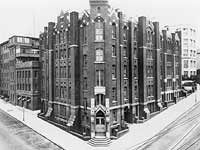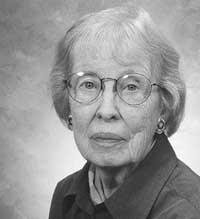Medical School Recollection
  |
|
Eleanor Rodgerson, MD, alumna and active member of the Sierra Sacramento Valley Medical Society, which honored her with the 2001 Golden Stethoscope Award. top: Stanford medical school in San Francisco. |
|
In the 1930s a woman entering the medical profession was out of the ordinary
Joyce Thomas
Anatomy. The first class in the first year of medical school took place in a long, cold room, with rows of examining tables that held shrouded objects smelling of formaldehyde — their stark contents to be disclosed and investigated. Eleanor Rodgerson, MD, class of 1935, still recalls the “fear and apprehension” the class evoked for her and other young medical students. Biochemistry followed, with its own particular anxieties, this time in the form of sliderules, which some classmates adroitly used for quick calculations but she had never even seen before.
At a time when very few women studied medicine, there were five women in this incoming class of 50 students, more than twice the national average — not an unusual statistic for Stanford where women had been admitted to train in medicine from the school’s earliest days. Overall, Rodgerson noticed little prejudice or discrimination though individual instances of bias did occur. For example, the urology professor permitted no females in his class. And a woman physician gave a short course in contraception one afternoon — but no women were allowed to attend! In the final year, however, competition for residencies grew very intense and then just being female became a drawback. Rodgerson recalls hearing comments such as “You’ll get pregnant and drop out” or “You’ll take a good man’s place.”
The first year, on the Stanford campus, had allowed for quiet and meditation. The second year brought the excitement of living in San Francisco and studying at Lane Hospital, one of an imposing array of medical school buildings at Webster and Clay.
“It was exciting, the steady murmur of activity stimulating,” Rodgerson recalls. Beginning clinical students “worked up” patients, doing all the preliminary blood work and preparing for formal rounds with formidable, exacting professors. “We were the lowest rung of the medical hierarchy,” she says. In the “L” (lues venera, i.e. syphilis) clinic, students perfected intravenous and intramuscular injection techniques using arsphenamines and bismuth, chemicals that predated antibiotics in the treatment of the disease, which was called by its more acceptable Latin name.
Some clinical cases were seen at San Francisco County Hospital. Normally, the students rode the streetcar from Lane to County but one day a fellow student drove her little, two-seated car, with four occupants in all. The smallest woman sat on Rodgerson’s lap. On the way back to Lane, all went well until at a busy intersection, a car hit them. Slowly, their car tumbled over. A policeman ran up, opened the upper door and the women climbed out, one by one, groaning but not hurt. “Passersby watched in amazement as we continued to emerge from the vehicle,” she says. Then the four students transferred to a streetcar.
“Medical school was a foundation and a beginning, but only a beginning,” says Rodgerson now. “As years passed, I became more and more conscious of how much more knowledge and practice would be necessary to care for and better the problems of patients. It took more years of contact to take what I had learned and to apply it with empathy.”
Comments? Contact Stanford Medicine at

